Effect of Border Crops on Activity of Predatory Fauna In Blackgram (Vigna Mungo L.)
0 Views
N. SREESANDHYA*, S. DHRUVA, M.S.V. CHALAM, P. KISHORE VARMA, MOHAN NAIDU AND M. RAJASRI
Department of Entomology, S.V. Agricultural College, ANGRAU, Tirupati-517 502.
ABSTRACT
The aim of this study was to investigate the impact of various border crops viz., maize, pearl millet, fodder sorghum, foxtail millet, sunhemp, dhaincha, sunflower and marigold on predator populations, specifically coccinellids and spiders in blackgram as major crop. The research was conducted at the Agricultural College Farm, Naira, ANGRAU, during the rabi seasons of 2021-22 and 2022-23.The findings revealed that the populations of coccinellids in blackgram crop with marigold and maize as border crops were 24.63 and 24.30 numbers per 10 plants, respectively. Similarly, the spider populations were recorded at 16.73 and 16.50 numbers per 10 plants for marigold and maize, respectively. These populations were significantly higher compared to the sole blackgram crop, which had an average of 13.5 coccinellids and 10.55 spiders per 10 plants across both vegetative and reproductive stages. Notably, all other border crops were statistically comparable to marigold and maize in terms of spider population, with the exception of the blackgram sole crop. It is concluded that, marigold and maize crops were found to be effective border crops for enhancing predator population in blackgram.
KEYWORDS: Blackgram, biodiversity, border crops, coccinellids and spiders.
INTRODUCTION
Blackgram (Vigna mungo) contain 22-24 per cent protein, which is almost twice the protein in wheat and thrice that of rice. Pulses provide significant nutritional and health benefits, and are known to reduce several non communicable diseases such as colon cancer and cardiovascular diseases (Jukanti et al., 2012). Protein, energy, malnutrition as well as micronutrient deficiencies can be addressed by increasing the consumption of pulses which are a rich source of proteins, minerals, iron and fibre.
The urdbean production of India was 2.78 million tonnes from an acreage of 4.63 million hectares with a productivity of 600 Kg/ha. (http://des.ap.gov.in/). India is the largest producer and consumer of urdbean and its production contributes to 11 per cent of India’s total pulses production (25.46 million tonnes in 2020- 21) (Agricultural Statistics Division, DES, MoAF & W, 2022). According to 1st Advance Estimates of Production of Food grains for 2022-23, all India blackgram production estimate was 1.84 million tonnes.
Andhra Pradesh produced 4.29 lakh tonnes of blackgram in an area of 4.01 lakh ha during 2021-22.
According to 1st advance estimates during kharif 2022- 23, blackgram was grown in 0.38 lakh hectares with a production of 0.35 lakh tonnes and productivity was 927 kg ha-1. Among the major producing states, productivity was highest in Andhra Pradesh (915 kg ha-1), followed by Jharkhand (879 kg/ha) during 2020-21 (https://iipr. icar.gov.in).
The black gram ecosystem supports a diverse range of beneficial arthropods and insect pests. Recently, Agro cropping systems has emerged as a strategic approach that leverages habitat manipulation to boost the effectiveness of natural enemies and aims to significantly reduce or even eliminate insecticide use (Gurr et al., 2004).
This approach seeks to protect crops from insect damage by enhancing biocontrol services (Cullen et al., 2008). One method includes planting flowering crops along field borders, providing non-prey food sources and essential resources for natural enemies of crop pests when the main crop is not flowering (Wanner et al., 2006).
Despite these promising strategies, there is limited research on border cropping in black gram with pulse or non-pulse crops and its impact on the abundance of natural predators. This study, therefore, investigates the observed in the blackgram border cropping systems were importance of integrating black gram and other pulse depicted in Plate 1. and non-pulse crop varieties to support conservation biological control, focusing on the role of crop diversity in sustaining entomophages and enhancing pest suppression naturally.
MATERIAL AND METHODS
Field experiments were conducted during rabi 2021- to 10.81 spiders / 10 plants at 40 DAS.
22 and 2022-23 at Agricultural College, Naira (18.3828° N, 83.9460° E), Andhra Pradesh, India. Experiment was laid out in Randomized Block Design (RBD) consisting nine treatments and three replications with a field plot size of 5 X 6 m2. Blackgram variety LBG 752 was sown as main crop with a spacing of 30 X 10 cm. Maize (DHM 104), Pearl millet (ABV-4), Foxtail millet (Surya Nandi SIA 3088), Fodder Sorghum (SSG 59-3), Sunhemp (JRJ 610), Dhaincha (ACN-1), Sunflower (DRSH-1) and Marigold (Bengal Yellow ) were taken up as border crops in four rows with a spacing of 30 X 30 cm.
All border crops were sown at 30 days in advance crops to blackgram sowing to facilitate for the synchronized except flowering of both blackgram and border crops. Normal plants) agronomic practices like fertilizer application and manual weeding were carried out as per the recommended crop production practices of ANGRAU. No chemical pesticides were applied throughout the season.
In situ observations on the population of grubs and adults of various species of coccinellids (numbers/10 plants) on blackgram and intercrops from 10 randomly selected plants from each replication were made. Standard taxonomic keys as prescribed by (Poorani,2002) were used for the identification of coccinellid species observed during the study. Observations were taken during early morning hours at seven days interval from 40 days after sowing (DAS) to 64 DAS.
STATISTICAL ANALYSIS
The data on predators viz., coccinellids and spiders (no’s per 10 plants) was subjected to analysis of variance (ANOVA) and Duncan’s Multiple Range Test (DMRT) (P ≤ 0.05).
RESULTS AND DISCUSSION
Coccinellid species observed
Coccinellid species viz., Chielomenus sexmaculata, Coccinella transversalis and Micraspis sp. were observed in the blackgram border cropping systems were depicted in Plate 1.
Impact of border crops on predatory fauna in blackgram during rabi, 2021-22
The results pertaining to predatory fauna during rabi, 2021-22 were presented in Table 1. ranging
between 10.69 to 18.36 coccinellids / 10 plants and 5.50 to 10.81 spiders / 10 plants at 40 DAS.
At 47 DAS, highest coccinellid population was recorded in blackgram crop with marigold as border crop (24.25 no’s/ 10 plants) followed by dhaincha (22.91 no’s/ 10 plants) and maize (22.68 no’s/ 10 plants) respectively, which were observed to be statistically at par with each other. The lowest coccinellid population was recorded in the blackgram crop with foxtail millet as border crop (13.59 no’s/ 10 plants) followed by blackgram sole crop (14.11 no’s/ 10 plants) were found to be statistically at par with each other. Whereas, the spider population was observed to have equally enhanced by all the border ranging between 11.26 to 18.63 spiders/ 10 plants except in blackgram as sole crop (10.84 spiders/10 Normal plants) which was observed to be significantly different from blackgram crop with marigold as border crop and was at par with all other treatments.
At 54 DAS, highest coccinellid beetle population was recorded in blackgram crop with marigold as border crop (28.56 numbers/ 10 plants) followed by the blackgram crop with maize as border crop (27.16 numbers/ 10 plants) were statistically at par with each other and different from the coccinellid population recorded in blackgram sole crop (15.91 coccinellids/ 10 plants) showing the significance of border crop in attracting the predatory fauna.
Pertaining to spider population, the highest number of spiders (19.13 per 10 plants) were recorded in blackgram crop with marigold as border crop and lowest in blackgram sole crop (11.64 per plant) representing the influence of border crop in enhancing the predatory spider fauna at 54 DAS.
At 61 DAS, the predatory coccinellid fauna recorded were highest in the blackgram crop with maize as border crop (30.12 no’s/ 10 plants) followed by marigold as border crop (29.83 no’s/ 10 plants) were observed to be at par with each other. The lowest coccinellid population (16.36 no’s/ 10 plants) was recorded in blackgram with
Table 1: Effects of different border crops on natural enemy activity in Blackgram during
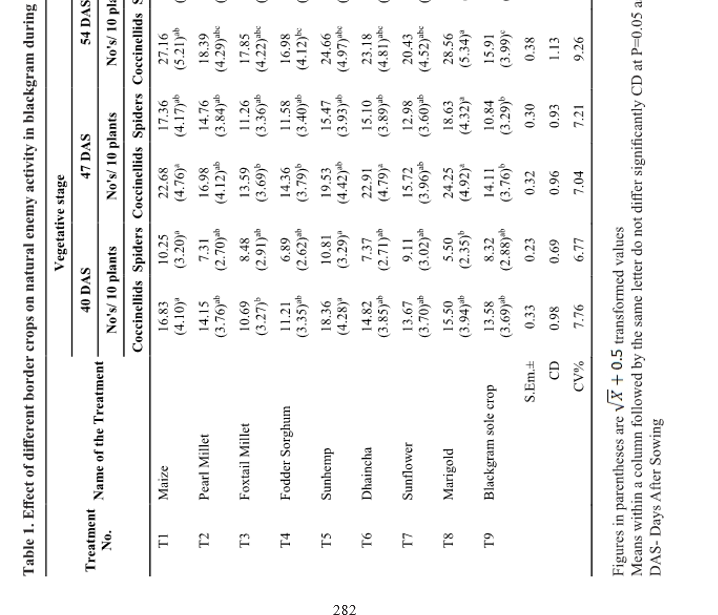
Table 2: Effects of different border crops on natural enemy rabi in 2021-2022
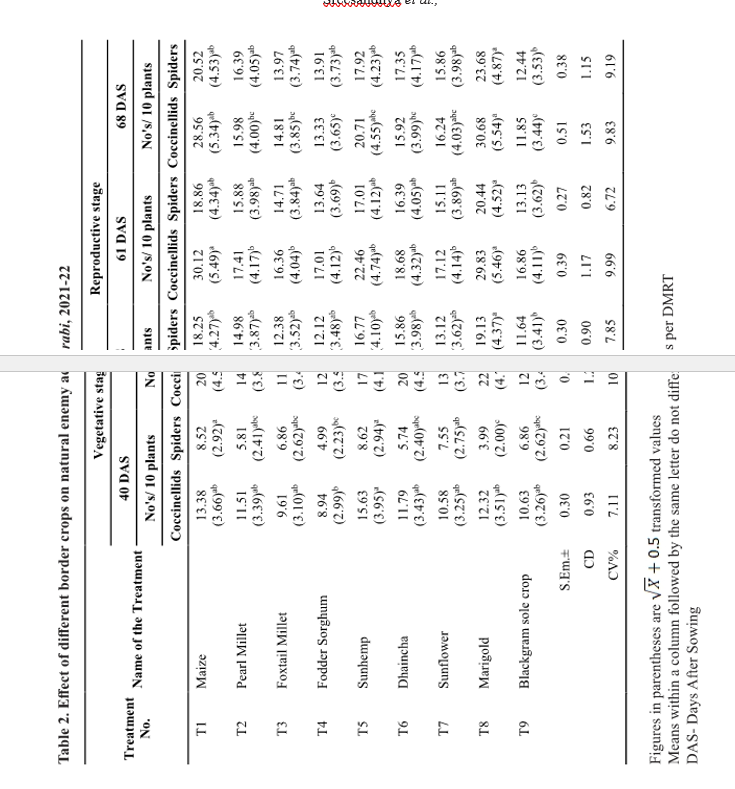
to enhance the predatory spider fauna on blackgram plants), sunflower (13.88 no’s/ 10 plants) and blackgram crop by recording 9.66 to 6.56 spiders/ 10 plants were bordered with foxtail millet (12.78 no’s/ 10 plants) as statistically at par except blackgram sole crop (2.59 border crops were observed to be statistically at par. But spiders/ 10 plants) which recorded the minimum.
Even at 54 DAS all the border crops were observed to exhibit their capacity in enhancing the predatory fauna of coccinellid ranging from 26.31 to 15.99 no’s/ 10 plants wer ea tpa rstatistically .Bu tth ecoccinelli dcoun trecorded in the blackgram crop with marigold (26.31) and maize (24.32) as border crops were statistically at par with each other and all other treatments except blackgram sole crop(14.75 no’s/ 10 plants) which recorded the minimum.
No statistical difference was observed in the spiders’ count (10.92 to 18.39 no’s/ 10 plants) recorded in blackgram crop with or without border crops at 54 23. DAS.
At 61 DAS, highest coccinellid count was recorded in blackgram crop bordered with maize (29.66 no’s/ 10 plants) followed by marigold (27.43 no’s/ 10 plants), blackgram bordered with sunhemp (20.82 no’s/ 10 plants), dhaincha (16.73 no’s/ 10 plants) and fodder sorghum (16.61 no’s/ 10 plants) were observed to be statistically at par with each other. Lower counts of coccinellid beetles were recorded in blackgram bordered with sunflower, foxtail millet, pearl millet and blackgram sole crop with 15.24, 15.32, 15.98 and 16.01 no’s/ 10 plants, respectively were at with each other and also with all other treatments.
Pertaining to Spiders, blackgram with marigold as border crop (19.71 no’s/ 10 plants) recorded the highest. Lowest population was recorded in blackgram sole crop 12.64 spiders/ 10 plants at 61 DAS.
At 68 DAS, all the blackgram plots with border crops viz., marigold, maize, sunhemp, pearl millet,
28.79 coccinellids/ 10 plants being statistically at par with each other Whereas the minimum coccinellid counts/ 10 plants were recorded in blackgram sole crop (9.65) followed by blackgram bordered with fodder sorghum (12.14) were on par statistically,
The spider population recorded in blackgram crop with marigold (21.22 no’s/ 10 plants), maize (19.25
no’s/ 10 plants), sunhemp (16.29 no’s/ 10 plants), pearl millet (15.66 no’s/ 10 plants), dhaincha (15.53 no’s/ 10 the predatory spider count recorded on blackgram sole crop (10.11 no’s/ 10 plants) was statistically minimum.
Impact of border crops on predatory fauna in Impact of border crops on predatory fauna in
The pooled mean of predatory fauna in the blackgram crop with maize, pearl millet, foxtail millet, fodder sorghum, sunhemp, dhiancha, sunflower and marigold as border crops was calculated from the mean
coccinellid beetles and spiders in vegetative stages (40 DAS and 47 DAS) and reproductive stages (54 DAS,61 DAS and 68 DAS) during rabi 2021-22 and 2022-23 . The pooled mean population of coccinellid beetles per 10 plants during vegetative stage i.e., 40 DAS and 47 DAS was observed to range between 10.08 to 23.42, where the highest population of 23.42 no’s/ 10 plants and 21.77 no’s/ 10 plants were recorded in blackgram crop with marigold and maize as border crops, respectively, displaying their efficacy in enhancing the beetle population. Similarly, pooled mean spider population per 10 plants during vegetative stage i.e., 40 DAS and 47 DAS ranged between 4.75 to 17.59, where the highest population of 17.59 no’s/ 10 plants and 16.96 no’s/ 10 plants were recorded in blackgram crop with marigold and maize as border crops, respectively, exhibiting statistical significance in attracting the spiders (Fig. 1).
Later, during reproductive stage (54 DAS, 61 DAS and 68 DAS) the coccinellid beetle population was observed to range between 10.75 to 29.89 no’s/ 10 plants, where the highest beetle population of 29.89 and 29.74 no’s/ 10 plants was observed to have recorded in blackgram crop with maize and marigold as border crops, respectively, displaying statistical significance over foxtail millet and fodder sorghum along with sol Blackgram crop during entire reproductive stage. The as border crop exhibiting its significance over foxtail millet and fodder sorghum as border crops along with blackgram as sole crop which were inferior in enhancing the predatory fauna during reproductive stage.
The grand pooled mean population of coccinellids and spiders in blackgram crop revealed that blackgram with marigold and maize as border crops were
Effect Of Border Crops On Predatory Fauna Activity In Black Gram
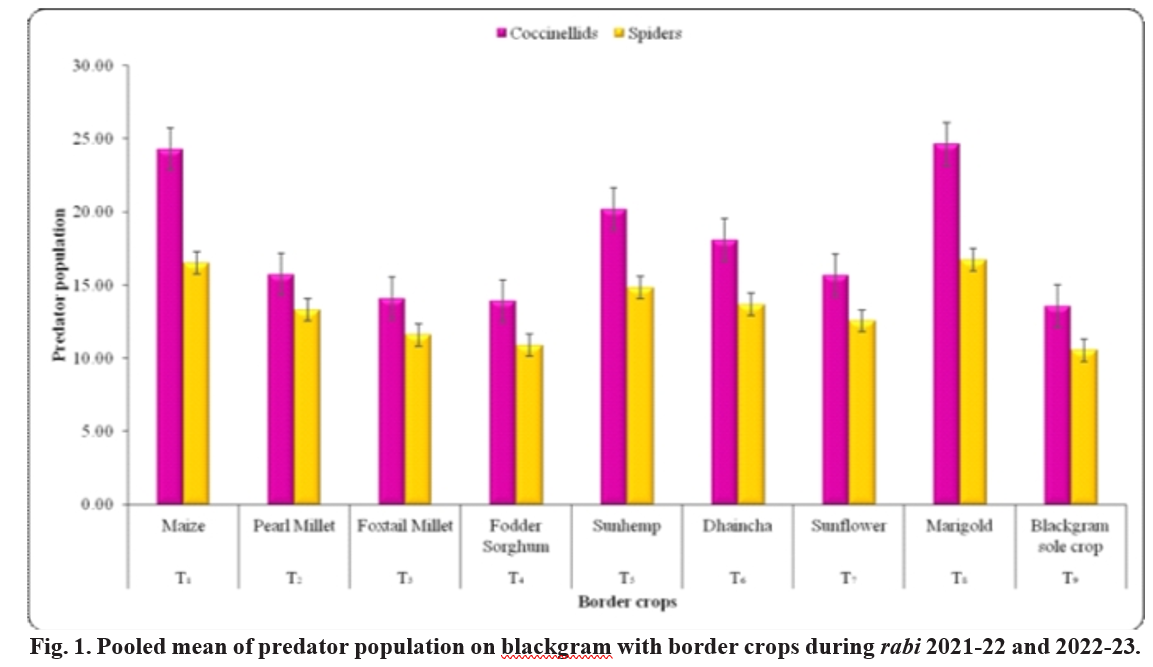
foxtail millet as border crop followed by blackgram sole crop (16.86 no’s/ 10 plants), and found to be statistically at par with each other.
The highest spider population per 10 plants was recorded in blackgram crop with marigold as border crop (20.44) followed by blackgram crop with maize (18.86), sunhemp (17.01), dhaincha (16.39), pearl millet (15.88), sunflower (15.11) and foxtail millet (14.71) as border crops were observed to be on a par each other. The lowest spider count was recorded in blackgram sole crop (13.13 no’s/ 10 plants)
A t6 8DAS, highes tcoccinelli dcount swer erecorded in blackgram with marigold and maize as border crops with 30.68 and 28.56 no’s/ 10 plants, respectively were found to be at par. The lowest coccinellid population was recorded in blackgram sole crop (11.85 no’s/ 10 plants).
A highest spider count of 23.68 no’s/ 10 plants was recorded in blackgram bordered with marigold showing the enhancing capacity of predatory population in the main crop statistically different from the lowest population (12.44 no’s/ 10 plants) noticed in blackgram without any border crop.
Impact of border crops on predatory fauna in blackgram during rabi, 2022-23
During rabi 2022-23, the maximum coccinellid population per ten plants was recorded in blackgram crop with sunhemp as border crop (15.63) followed by maize (13.38) and marigold (12.32) were statistically at par with each other at 40 DAS. The minimum coccinellid population per ten plants was recorded in blackgram crop with fodder sorghum as border crop (8.94). Whereas, the predatory spider fauna was recorded highest with 8.62 (blackgram with sunhemp as border crop) followed by 8.52 (maize), 7.55 (sunflower), 6.86 (foxtail millet and blackgram sole crop), 5.81 (pearl millet) and 5.74 (blackgram with dhaincha as border crop) spiders/ 10 plants were statistically at a par with each other (Table. 2)
At 47 DAS, all the border crops exhibited effectiveness in upgrading the predatory Coccinellid population on blackgram ranging between 22.58 no’s/ 10 plants (with marigold as a border crop) to 12.48 no’s/ 10 plants (with fodder sorghum as border crop) except in the blackgram sole crop (12.14 no’s/ 10 plants) and blackgram bordered with foxtail millet (11.95 no’s/ 10 plants). Similarly, all the border crops were observed
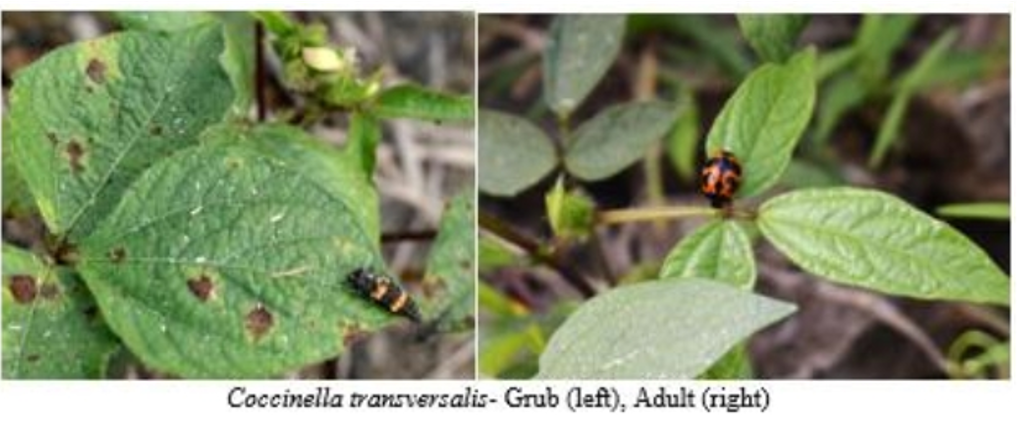
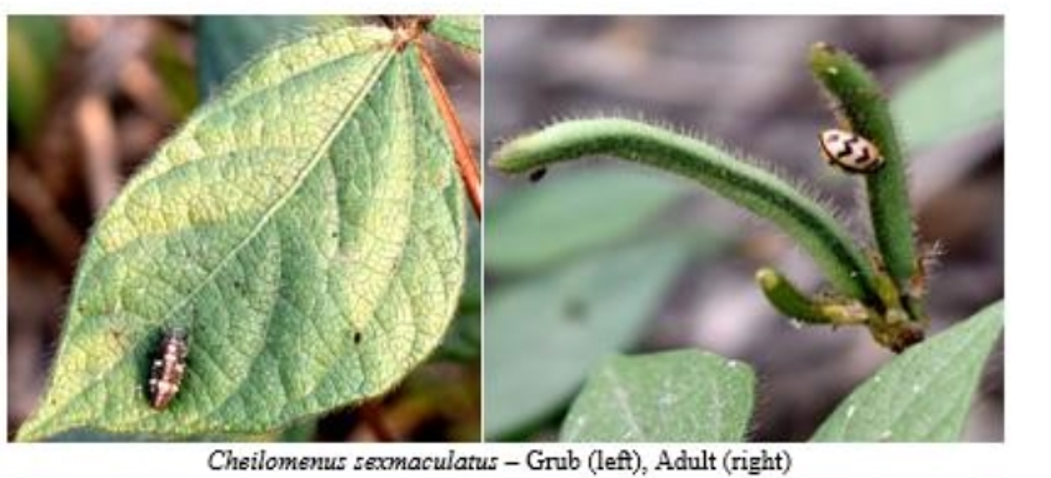
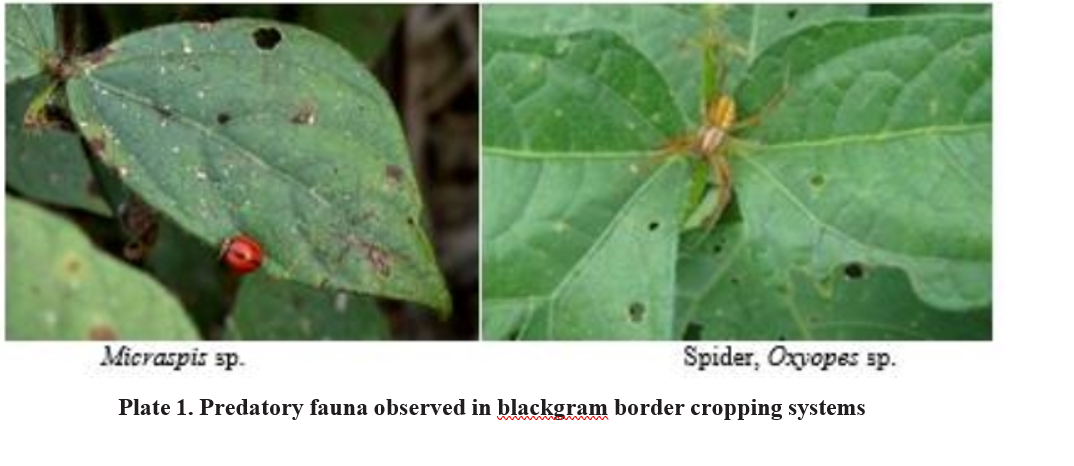
outperformed in enhancing the coccinellid population Cheilomenes sexmaculata and spiders on pigeon pea (24.63 and 24.30 no’s/ 10 plants, respectively) and bordered with sorghum displaying the prominence of spider population (16.73 and 16.50 no’s/ 10 plants, border crops in escalating the count of predatory fauna respectively) exhibiting significance over blackgram on the host crop was in concurrence with present studies.
as sole crop with 13.5 no’s coccinellids / 10 plants and 10.55 no’s spiders/ 10 plants collectively during both vegetative and reproductive stages. However, all other border crops were statistically on par with marigold and maize pertaining to spider population except blackgram sole crop.
he present studies were observed to be inaccordance with the results fetched from the field experiments conducted on blackgram intercropped with maize, sunflower and marigold recorded 4.92, 4.58 and 4.46 coccinellids/ plant, respectively, followed by sorghum 3.65 no’s coccinellids /plant ) compared to black gram (2.08 coccinellids / plant) when cultivated alone (Lokesh et al. 2017). As well, the studies made by Selvam and Rajvel (2018) found that black gram intercropped with maize recorded the maximum number of coccinellids and spiders population (2.68 coccinellids/ plant and 1.73 spiders/ plant) followed by marigold ( 2.52 coccinellids/ plant and 1.70 spiders/ plant) and a minimum of 1.78 coccinellids and 0.96 spiders per plant were recorded in sole blackgram crop was similar to the present studies where maximum population of coccinellids and spiders were observed in black gram crop with marigold and maize as border crops . Analogous studies made by Parthiban et al. (2018) in groundnut based intercropping also revealed that highest coccinellid population of 8.11 and 5.94 no’s/ 10 plants was recorded with maize and pearl millet as inter crop while it was only 1.73 no’s/ 10 plants in sole groundnut crop.
The work done by Sheeba et al. (2020) was also in concurrence with the present studies in enhancing the predatory coccinellid population (1.10 no’s/plant) through cultivation of sorghum and that of the spider population by cultivating pearl millet (0.73 no’s / plant) and sorghum (0.67 no’s/ plant ) as intercrops in sesame towards management of capsule borer .
Sing he tal. (2013 )showe dtha tpigeo npe aintercrops had significant influence to enhance the population of spiders (0.75 no’s/plant) in pigeon pea bordered with rice and pigeon pea + pearl millet (0.67 no’s/plant) where the sole pigeon pea recorded 0.42 spiders / plant. Similarly, Sujayanand et al. (2021) recorded a mean of 0.77, 0.85 and 0.76 no’s per plant of Coccinella septumpunctata,
Escalated appearance of mean number of coccinellids (3.80 /plant) and spiders (4.20 / plant) were observed in groundnut (Indiragandhi et al., 2018) when farmscaped with border crops like sorghum, sunflower, pearl millet and maize where Sujayanand et al. (2016) noticed that the treatments having maize, marigold and coriander as intercrops in okra recorded highest population of predatory fauna.
Studies by Ogenga-Latigo et al., 1992 shown that in crop mixtures, variations were observed herbivore load which in turn increased the abundance of natural enemies.
Flowering can be used as attractant plants to encourage coccinellids in and around pulses (NIPHM, 2014).
The effectiveness of intercropping in pest management is supported by studies made by Lokesh et al. (2017), which demonstrate that interplanting maize with cowpea enhances biodiversity within crop systems, resulting in increased populations of natural enemies. The diversity of microhabitats within this intercropping system provides multiple resources, such as prey, nectar, and pollen, creating a favorable environment for predator colonization and population growth. In contrast, monocultures tend to lack such diversity, often leading to higher pest pressures due to the absence of natural biological control mechanisms.
Moreover, intercropping and border cropping influence pest dynamics through various ecological mechanisms. Soundarajan and Chitra (2012) identified several factors by which diversified cropping systems can suppress pest populations. These factors include attracting natural enemies, disrupting pest dispersal patterns through physical and environmental changes, and creating microclimatic conditions such as altered temperature and moisture that may hinder pest reproduction or survival. Furthermore, the physical arrangement of different crops can serve as a barrier, restricting pest movement and limiting their ability to reach susceptible plants.
Border cropping of blackgram with maize and marigold could be a better choice for conserving the coccinellids species and spiders which would in turn facilitate for the natural suppression of insect pests.
LITERATURE CITED
Cullen, R., Warner, K. D., Jonsson, M and Wratten, S.
- 2008. Economics and adoption of conservation biological control. Biological Control. 45: 272–280.
Gurr, G. M., Wratten, S. D. and Altieri, M.A. 2004. Ecological engineering: advances in habitat manipulation for orthropods collingwood Australia CSIRO publishing 232.
Indiragandhi, P., Meena, B and Ushakumari, R. 2018. Eco-feast crop plants for insect pest management in groundnut. Journal of Pharmacognosy and Phytochemistry. SP 1: 1469-1474.
Jukanti, A. K., Gaur, P. M., Gowda, C. L. L., and Chibbar, R. N. 2012. Nutritional quality and health benefits of chickpea (Cicer arietinum L.): a review. British Journal of Nutrition. 108(S1), S11-S26. Cambridge University Press.
Poorani, J., 2002. An annotated checklist of the coccinellidae (Coleoptera) (excluding Epilachinae) of the Indian Sub region. Journal Oriental Insects. 36: 307-383.
Lokesh, S., N. Muthukrishnan, N. Ganapathy, J.R. Kannan Bapu and Somasundaram, E. 2017. Ecological Engineering of Intercropping in Blackgram Promotes Services of Coccinellids and Suppress Aphis gossypii (Glover). International Journal of Current Microbiology and Applied Sciences. 6(11): 1963-
1972.
NIPHM (National Institute of Plant Health Management). The AESA based IPM. Brinjal. 23.
Ogenga-Latigo, M.W., Ampofo, J.K.O., Baliddawa, C.W., 1992. Influence of maize row spacing on infestation and damage of intercropped beans by the bean aphid ( Aphis fabae Scop.). 1.Incidence of aphids. Field Crops Research. 30: 111–112.
Parthiban, P., Chinniah, C., Baskaran, R. M., Suresh, and Ravikumar, A. 2018. Positive Influence of Intercrops on Natural Enemies in Groundnut Eco- System. International Journal of Research Studies in Zoology. 14:1-6.
Selvam, K and Rajavel, D. S. 2018. Influence of various intercrops on podborers of Blackgram. International Journal of Trend in Scientific Research and Development. 2(5):1029-1043.
Sheeba, R., Indiragandhi, P., and Motilal, A. (2020). Diversified cropping system for managing major insect pests in sesame. Journal of Pharmacognosy and Phytochemistry. 9 (2S), 227-231.
Singh, R. S., Nath, P and Kumar, A. 2013. Effect of biorational approaches for the management of blue butterfly (Lampides boeticus L.) in pigeonpea. Agricultural Science Digest. 33: 299-303.
Soundararajan, R. P. and Chitra, N. 2012. Impact of intercrops on insect pests of black gram, Vigna mungo L. Journal of Entomology. 9: 208-219.
Sujayanand, G.K., Chandra, A., Pandey, S., Bhatt, S. 2021. Seasonal Abundance of Spotted Pod Borer, Maruca vitrata Fabricius in Early Pigeonpea [Cajanus cajan (L.) Millsp.] and its Management through Farmscaping in Uttar Pradesh. Legume Research. 44(2): 233-239.
Sujayanand, G.K., Sharma, R.K. and Shankarganesh, K. 2016. Impact of intercrops and border crops on pest incidence in okra. Indian Journal of Horticulture. 73(2): 219-223.
Wanner, H., Gu, H., Gunther, D., Hein, S and Dorn, 2006. Tracing spatial distribution of parasitism in fields with flowering plant strips using stable isotope marking. Biological Control. 2: 39.
https://iipr.icar.gov.in/urdbean/
http://des.ap.gov.in/
- Effect of Foliar Application of Nano Urea on Growth and Yield of Fodder Maize
- Studies on Effect of Antibiotic on Biological Parameters Of Diamondback Moth, Plutella Xylostella (Linnaeus)
- Estimation of Genetic Variability for Yield and Yield Attributing Traits in Sesame (Sesamum Indicum L.)
- An Economic Analysis of Community Hiring Centres (Chcs) in Chittoor District of Andhra Pradesh
- Development and Validation of Gc-Ecd Method for Determination of Profenophos in Pigeonpea
- Assessment of Soil Major Nutrients in Scarce Rainfall Zone of Andhra Pradesh

